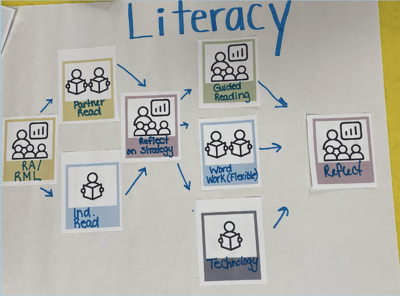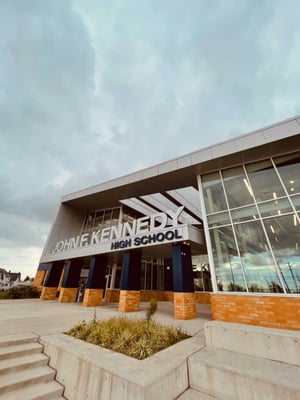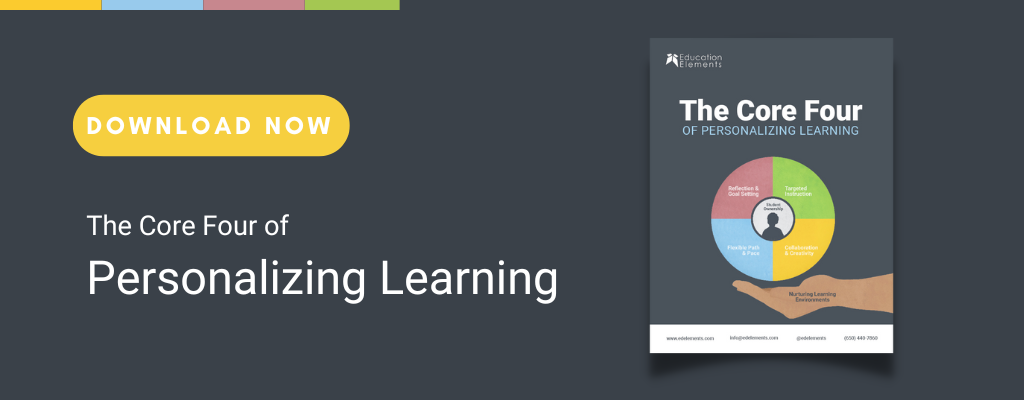The bright morning sun floods in through the yawning glass windows and casts long shadows in the front of the classroom. My colleague and I and about ten-odd teachers sit huddled at the desks near the back; some of them are poring over resources on their screens, others using markers, pens, and paper cutouts on small chart paper. INDEPENDENT PRACTICE, the text underneath one of these cutouts proclaims. The teacher draws an arrow to the right, as though to sequence the steps, and then draws a sort of three-step cycle that takes up most of the space. THREE STATION ROTATION, the teacher then proclaims in green marker and proceeds to describe in small writing what students are expected to do in each station during her 9th grade English class.

Instructional Models to Support School Improvement
 It is fall, and we are once again at the state-of-the-art John F Kennedy High School in Cleveland, Ohio. In the spring of last year, we published a blog post detailing the work our Ed Elements team did to support the first cohort of teachers implementing blended learning in their classrooms, now a district initiative. The teachers in the first Cohort saw success and growth in their classrooms, and leaders at JFK, primarily Mrs. Lori Crum, wanted to capitalize on this momentum.
It is fall, and we are once again at the state-of-the-art John F Kennedy High School in Cleveland, Ohio. In the spring of last year, we published a blog post detailing the work our Ed Elements team did to support the first cohort of teachers implementing blended learning in their classrooms, now a district initiative. The teachers in the first Cohort saw success and growth in their classrooms, and leaders at JFK, primarily Mrs. Lori Crum, wanted to capitalize on this momentum.
This year, we are working with two Cohorts simultaneously. Cohort 1 teachers refine their practice and provide guidance, expertise, and perspective, and Cohort 2 teachers dive headfirst into the Core Four of Blended Learning and design instructional models best suited to their classrooms.
At the center of this work is the school’s Academic Achievement Plan (AAP), a comprehensive document created and voted on by the entire staff which outlines the goals for school improvement and the strategies it will follow in order to reach those goals. Last year, our team’s primary goal was to cultivate a cohort of change-makers. This year we have focused just as much time on working directly with the school leadership team, helmed by Mrs. Crum, to support the development of the instructional leadership capacity necessary to scale and sustain this work long-term, and meet the improvement goals outlined in the AAP.
Developing instructional leadership capacity
Our work with Mrs. Crum centers on building systems and structures for routine data collection using Ed Elements’ Cour Four Look Fors. During the course of the Fall semester, our team led two Learning Walk days with consistent classroom visits in the interim. Learning Walks are opportunities for our team to (1) get a pulse check on implementation in order to identify areas of strength and challenge to inform support plans and (2) model the process for the JFK team so that they feel confident they can conduct walkthroughs and give constructive feedback on blended learning implementation without Education Elements support. During our check-ins, Mrs. Crum shares the progress teachers have made based on the Core Four rubric and creates action items for her staff based on the data she collected. This work is meaningful to her as a leader, as she describes:
“Our partnership this year has assisted me tremendously as a leader. This work supports me in planning, organizing, and supporting teachers. This ultimately improves instruction in the classroom for students. It is critical that we provide a strong core instruction focus. We want to ensure that every classroom at John F. Kennedy High School meets the needs of all of its diverse learners.” She added “We want our classrooms to be engaging, relevant, rigorous, and student-centered. This work has also allowed me to prioritize what is important. It was important for our team—both teachers and administrators—to come together, review the current instructional practices, and make some modifications within the school year. As our teachers grow in this work so do our students which ultimately improves academic achievement.”
Blended Learning implementation supports campus improvement goals
In early 2023, we worked with the JFK leadership team to develop a comprehensive walkthrough tool built on the skeleton of the Core Four tool. During an energetic in-person strategy session in mid-January, we crosswalked the Look Fors identified in the AAP, as broken down by core content and support areas, with the Core Four to create an all-encompassing instructional walkthrough document. The hope is this will be used to collect data that encompasses the work both the leadership team and teachers have done over the past two years.
When we asked Mrs. Crum how Blended Learning Implementation supports the goals outlined in the AAP, she responded:
“The pandemic changed the delivery of instruction for all students globally. The Flex model has supported John F. Kennedy High School’s campus goals by providing options and choices for our students. This model gives students a hybrid of both traditional and online learning. Students have the ability to demonstrate mastery through a variety of methods such as presentations, inquiry-based, etc. The Flex model has allowed our students to have control over their learning, and our teachers to personalize instruction. This delivery of instruction aligns with our Academic Achievement Plan (AAP) and goals.”
Towards the end of February, we led a Reflect + Iterate workshop with teachers from both Cohorts. Our team walked away feeling incredibly inspired by their commitment to growth. We emphasized the power of small shifts leading to positive ripple effects over time and the ability to influence change with personal practices. Not only were these tenacious educators diving into the Core Four with grit and openness, but they also showcased their investment to the learning process by scheduling follow up meetings with one another in real time to hold each other accountable for growth. The future looks promising at JFK High.
